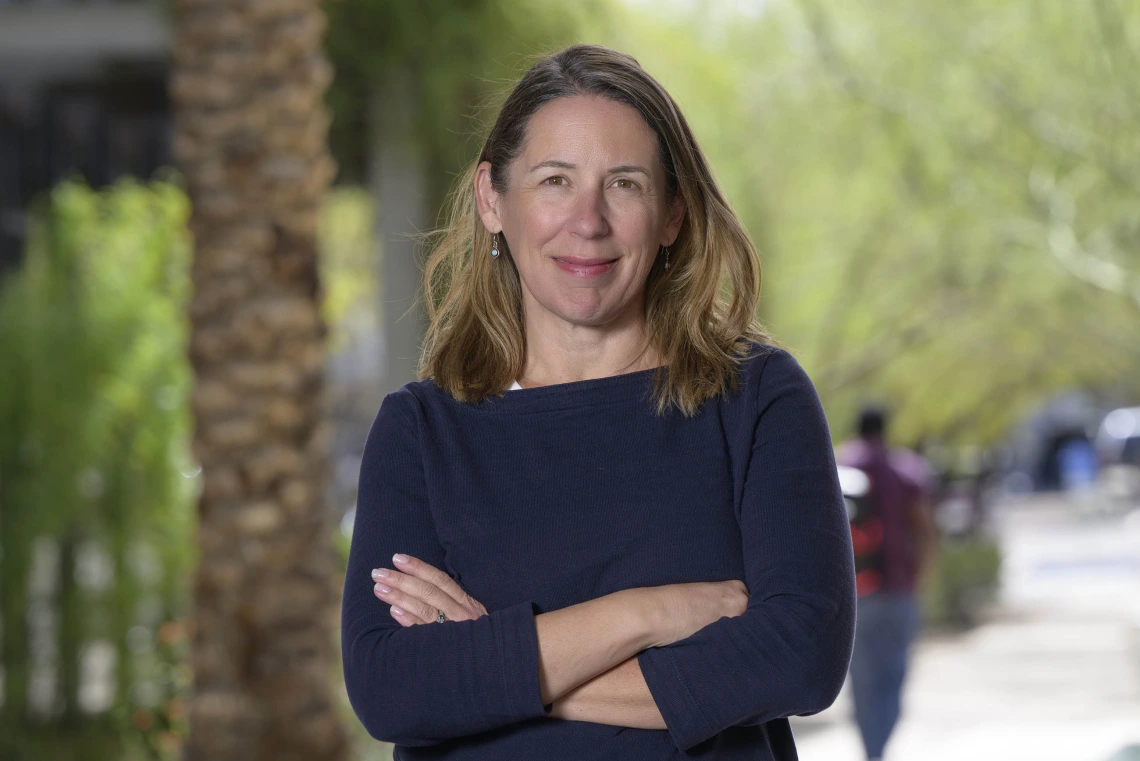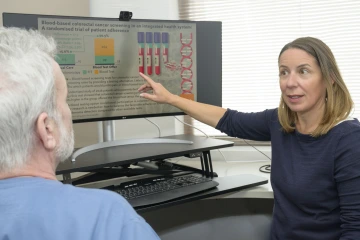Connecting with Gloria Coronado
New Center for Health Disparities Research director sees community partnerships, outreach as key to closing health disparity gap.

Gloria Coronado, PhD, has a joint appointment to lead the Center for Health Disparities in the Mel and Enid Zuckerman College of Public Health and as the associate director of Population Sciences and holds the Maynard Chair in Prevention Research at the Cancer Center.
Gloria Coronado, PhD, joined the University of Arizona Mel and Enid Zuckerman College of Public Health to lead the Center for Health Disparities Research in November and has a joint appoint with the UArizona Cancer Center. She brought with her a passion for examining how factors like the COVID-19 pandemic impact cancer screenings and care. That’s not surprising since she joined the university from Kaiser Permanente Northwest Center for Health Research, where she led a program on health disparities research that focused on community health centers, Medicaid health plans and rural clinics.

Gloria Coronado, PhD, speaks with Karl Krupp, PhD, an assistant professor of public health practice in the Mel and Enid Zuckerman College of Public Health. Coronado leads an NCI-funded RESTORE study, which looks at how COVID-19 has affected cancer screenings and follow-ups for breast, cervical and colorectal cancers.
As part of her joint appointment, Coronado is also the associate director of Population Sciences and holds the Maynard Chair in Prevention Research at the Cancer Center. There, she will recruit and develop population-based researchers focused on underserved and under-researched communities.
Health Sciences Connect caught up with Coronado recently to discuss how digital epidemiology and big data can help close health-disparity gaps as well as why diversity is critical in research.
You’ve been at the University of Arizona since November. What has been the biggest surprise for you?
The most surprising aspect has been the abundance of opportunities for community-engaged research available here. The Zuckerman College of Public Health and the UArizona Cancer Center boast numerous strengths, including a diverse population in the catchment area; dedicated and collaborative scientists; and robust community partnerships.
What area are you particularly excited about?
I am excited about leveraging academic and community partnerships and the rich data resources available at the University of Arizona. Scientists here have successfully taken advantage of large epidemiologic cohorts and the university has access to statewide Medicaid claims data (2.5 million covered lives). Historically, our research enterprise has relied on data from non-Hispanic white people, predominantly males. I am eager to contribute to national goals on the representation of medically underserved groups in clinical trials and research. Specifically, I am interested in using Medicaid claims data and geography-based tools to identify areas of low cancer screening participation. By forming strategic partnerships with community organizations and clinics that serve these areas, we can assess social drivers of health and deliver health services to areas and populations that need them the most.
What unique barriers exist in Arizona?
Geographic factors can present challenges, especially in rural areas where access to health care services, including cancer screenings and treatment facilities, may be limited. This disparity underscores the importance of outreach programs and telehealth initiatives to ensure equitable access to cancer care and prevention service across the state.
Unique environmental factors create challenges and opportunities, such as exposure to ultraviolet radiation from the sun. Luckily, the university has a strong Skin Cancer Institute, which focuses research on prevention strategies, public education campaigns and early detection efforts tailored to the local community.
One significant opportunity is the diverse demographic makeup of the state. Understanding and addressing the specific needs and disparities within these populations require tailored approaches and culturally sensitive interventions. With the U.S. population becoming increasingly diverse, I'm thrilled that the university is taking the lead in spearheading these crucial efforts for our nation.
Overall, addressing these unique barriers requires collaborative efforts among researchers, health care providers, community organizations and policymakers to develop comprehensive strategies that promote cancer prevention, early detection and access to quality care for all populations in the state.
How can digital epidemiology reduce health care disparities?
The COVID-19 pandemic really highlighted the need for alternative ways to connect with patients beyond traditional face-to-face visits. That's where digital health comes in. But here's the catch, a lot of these digital tools aren't designed with diverse populations in mind. Many app-based tools used to engage study participants are only being used for English-speaking populations. I believe that by teaming up with local groups and tapping into the diverse communities here, the university can lead the charge in making digital health more inclusive.
Purnima Madhivanan, PhD, MBBS, MPH, and others have already made strides in creating digital stories to raise awareness about HPV vaccination. Similarly, my team has been working on short videos and fotonovelas and testing programs that send these communications via text to encourage colorectal cancer screenings in Hispanic communities.

Gloria Coronado, PhD
How will the use of big data close the gap on health disparities?
When you talk about big data, it’s a bit of a double-edged sword in health care disparities. On the one hand, it has the power to reveal and address those gaps; but on the other, it can also perpetuate them if the data isn’t representative. We’ve seen a trend where prediction models, based on limited data from underrepresented groups, end up leading to less accurate care. As scientists, it is crucial that we make a conscious effort to include diverse populations in our big data analyses.
That’s why I’m so passionate about my NCI-funded RESTORE study, which looks at how COVID-19 has affected cancer screenings and follow-ups for breast, cervical and colorectal cancers. We’re diving into data from the largest federally qualified health center in the United States, where upward of 83% of patients are ethnically Hispanic. By understanding their experiences, we can update disaster preparedness plans to better serve clinics like these. I truly believe the university is in a prime position to take the lead nationally in these critical efforts.
The social determinants of health include historical and current unequal distribution of resources. How does a lack of diverse researchers impact this?
I recently served on the National Academies of Sciences and Engineering Committee on Improving Representation of Women and Minorities in Clinical Trials and Research. A key recommendation of that group was to diversify our scientific workforce. By having scientists from diverse backgrounds and experience, we can more successfully reach communities so that they receive the benefits of our scientific discoveries.
What can be done to increase the diversity of researchers?
Given its Hispanic-serving designation, the university has a special chance to nurture its own diverse talent pool. Offering robust training programs for students and fostering a culture that values mentorship can greatly contribute to grooming the upcoming generation of varied and skilled scientists.
What role does diversity, equity and inclusion play in eliminating health disparities?
It plays a huge role. It’s not just about advancing science to find new ways to diagnose or treat disease, it’s also about who’s at the table making decisions about guidelines and policies at all levels. We need a diverse scientific workforce that reflects the communities we serve. When people from diverse backgrounds and experiences come together, we get a more comprehensive understanding of health needs and we come up with better solutions. When team members with diverse backgrounds collaborate, they can combine their expertise and experiences to generate novel approaches and breakthrough discoveries.
So, it’s not just a nice-to-have, it’s a must-have if we’re serious about closing gaps in health and health care.
What advice would you give to young people interested in a similar career?
My advice to aspiring scientists and researchers is to remain curious and persistent. Embrace challenges as opportunities for growth, collaborate with diverse teams and never underestimate the value of interdisciplinary approaches. Remember, every setback is a steppingstone toward new discoveries and contributions to science.

